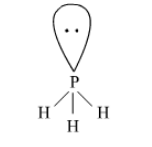What do you expect the nature of hydrides is, if formed by elements of atomic
numbers 15, 19, 23 and 44 with dihydrogen? Compare their behaviour towards
water.
The elements of atomic numbers 15, 19, 23, and 44 are phosphorus, potassium, vanadium, and ruthenium respectively.
1) Hydride of phosphorus
Hydride of nitrogen (PH3) is a covalent molecule. It is an electron-rich hydride owing to the presence of excess electrons as a lone pair on phosphorus.

2) Hydride of potassium
Dihydrogen forms an ionic hydride with potassium owing to the high electropositive nature of potassium. It is crystalline and non-volatile in nature.
3) Hydrides of Vanadium and Ruthenium
Both vanadium and ruthenium belong to the d–block of the periodic table. The metals of d–block form metallic or non–stoichiometric hydrides. Hydrides of vanadium and ruthenium are therefore, metallic in nature having a deficiency of hydrogen.
4) Behaviour of hydrides towards water
Potassium hydride reacts violently with water as: $\mathrm{KH}_{(s)}+\mathrm{H}_{2} \mathrm{O}_{(a q)} \longrightarrow \mathrm{KOH}_{(a q)}+\mathrm{H}_{2(g)}$
Phosphorus (PH3) is covalent hydride and slightly soluble in water.
Hydrides of vanadium and Ruthenium do not react with water. Hence, the increasing order of reactivity of the hydrides is (V, Ru) H < NH3 < KH.
Click here to get exam-ready with eSaral
For making your preparation journey smoother of JEE, NEET and Class 8 to 10, grab our app now.
